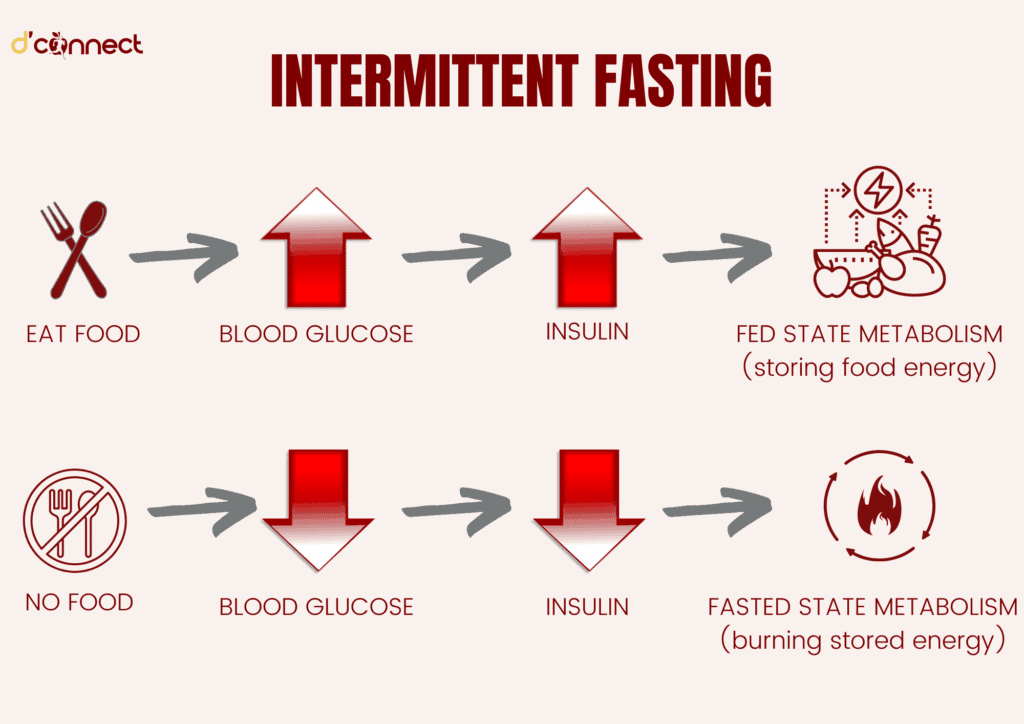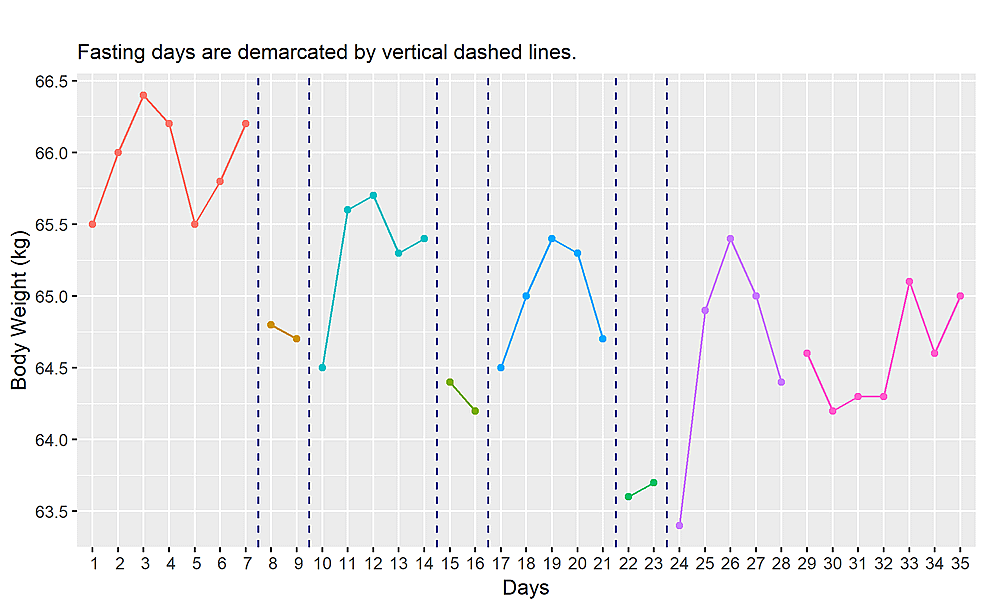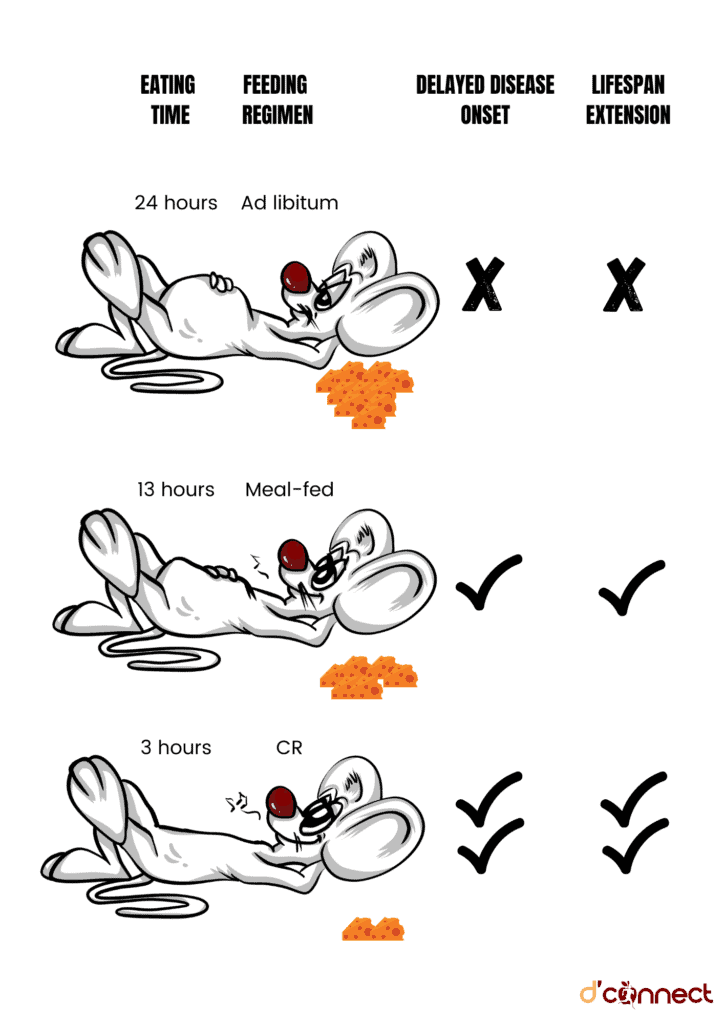
Molly Nguyen
BSc (Human Nutrition)
Note — The article was checked and updated August 2023.
Intermittent fasting refers to an eating pattern cycling between periods of fasting and eating. There are many ways to practice intermittent fasting, some of which include
- time-restricted eating
- 5:2 method
- alternate-day fasting
Intermittent fasting is claimed to have several health benefits, from weight loss to minimizing the risks of many chronic diseases such as diabetes, heart disease, cancer and even increasing our life expectancy.
Today we’ll look in-depth into what intermittent fasting is, how to apply it, what the proven health benefits are, and whether it is suitable for you.
What is Intermittent Fasting
Intermittent fasting is an eating pattern that involves alternating between fasting and eating periods on a regular basis. It is a voluntary restriction of foods for health, spiritual, and other reasons. There are various definitions that encompass the term intermittent fasting, including:[1,2,3]
- time-restricted feeding (e.g. daily 16-h fast)
- alternate-day fasting (reduced meal frequency)
- 5:2 diet (fasting 2 days per week on non-consecutive days)
Intermittent fasting typically allows unrestricted intakes of foods and drinks when not fasting or can be used in combination with other dietary patterns, such as low-calorie diets, plant-based diets, or ketogenic diets.
RELATED — What is a plant-based diet: Vegan or Vegetarian?
The fasting period is defined as voluntary abstinence from foods and beverages whereas the eating period allows ad libitum food intake (free access to food).[3] To put it simply, we enter a fasting state when we do not eat for an extended period of time, for example, between dinner and breakfast the next day.

As we can see, intermittent fasting is not just another unrealistic short-term fad diet. When we skip breakfast and go for a long time without eating, that’s a form of intermittent fasting. Some may have been doing intermittent fasting their entire life without knowing it and their body is totally capable of handling this pattern of eating.
Intermittent fasting is not “starvation”
Starvation can lead to extreme suffering or even death.[5]
History behind Fasting
Intermittent fasting is not a new concept. In fact, fasting is a normal physiological adaptation in both animals and humans during times of food scarcity.[1]
Throughout recorded history, organisms have naturally evolved to fast when the food is not available for extended periods of time (e.g., hibernation during winter). Up until 12,000 years ago, ancient humans (hunter-gatherers) relied on gathering, hunting and fishing animals, and foraging for food.[6]
As there was no storage (e.g., refrigerators) or continuous supply of food (e.g., supermarkets), hunter-gatherer ancestors lived by what they found and their diets depended largely on the availability of food at that time. Once such tribe are the Maasai, pictured below.

As a result, humans have adapted to fasting for varying lengths of time by using stored energy in the liver and fat tissues, whereas our industrialized eating patterns nowadays usually include 3-4 meals per day plus snacks in between.
Religion and Fasting
Looking back in human history, various forms of voluntary fasting have been adopted by many religions as a way to purify the soul and the body. The most well-known example of this is Ramadan fasting, during which healthy adult Muslims must fast from sunrise to sunset for the whole month.[7]
Orthodox Christian fasting is another regimen of religious fasting, which usually occurs for a total of 180-200 days of fasting every year. The Orthodox monks are advised to avoid meat, fish, eggs and dairy products, olive oil, and alcohol every Wednesday and Friday throughout the year.[7]
Other types of religious fasting, such as Buddhism, Judaism, Seventh-Day-Adventism also involve the abstinence from certain types of food for varying durations for health benefits and spiritual reasons.[2,7,8]
In addition, various sources suggested that many well-known ancient Greek physicians and philosophers (Hippocrates, Plato, and Aristotle) had advocated the benefits of fasting for health and healing therapy.
Modern times and Fasting
The age-old idea of fasting that has been existing for millennia is now rebranded into a popular dietary pattern called “intermittent fasting”. The sudden peak of interest in intermittent fasting started in 2012, after the airing of Dr Michael Mosley’s documentary on BBC called “Eat, Fast and Live Longer”.[9]
This was followed by the publication of many popular books on intermittent fastings, such as The Fast Diet by the aforementioned Dr Michael Mosley, The 5:2 Diet by journalist Kate Harrison, or The Obesity Code by Dr Jason Fung.[10,11,12]
Since then, the trend of intermittent fasting has grown rapidly, becoming the most popular diet search term of 2019 on Google.[13]
To understand the reasons behind the growing popularity of intermittent fasting among high-profile individuals and researchers, let’s dive into the human body metabolic health effects during intermittent fasting.
What happens to the body when we are fasting
The metabolism in our body can be in either a fed state (storing food energy) or a fasted state (burning stored energy).[14]

Our body enters the fed state after the consumption of a meal when the body starts digesting and absorbing nutrients (sugars, amino acids, fats) from foods. As the digested nutrients enter the bloodstream, the blood glucose (sugar) starts to rise and insulin is released in response to glucose levels.[14,15]
Insulin is a key hormone required for glucose to enter the body cells
Glucose is used as an energy source or stored as glycogen in the liver and muscle tissues. Insulin can also stimulate the excess glucose to be stored in the form of fat in the liver and adipose tissues.[14,16]
As insulin concentrations correspond to the levels of glucose in the blood, which is high after meals and low between meals, constant high blood glucose levels over time can lead to insulin insensitivity (insulin resistance) – a condition associated with prediabetes and type 2 diabetes.[14]
Conversely, going through a couple of hours of not eating any foods (such as skipping meals or overnight fasting) puts our body in a fasted state. During the fasted state of metabolism, our insulin levels go down in response to a decrease in blood glucose concentration.[14,15]
As blood glucose needs to be maintained at a normal range (80-120 mg/dL), the liver starts converting glycogen (the most easily accessible fuel source) back to glucose to supply our body with energy. Because there is only limited storage of glycogen in the liver, the glycogen stores start to deplete after a prolonged duration of fasting, and our body starts to burn fat in the liver and adipose tissue (body fat) for energy.[14,15]
Intermittent fasting also induces several changes in the cellular and molecular levels that mediate its beneficial effects on health, disease, and aging. The changes associated with intermittent fasting include:
- Neurotrophic factors. The levels of neurotrophic factors (small proteins in the brain) increase during fasting, which protects the brain.[4]
- Proinflammatory cytokines. These are signalling molecules that promote inflammation. The levels of the cytokines decrease during fasting, which helps reduce inflammation.[4]
- Insulin. Insulin levels drop and insulin sensitivity increases after a period of fasting, thus improving glucose metabolism and assisting in weight loss.[4,17]
- Ketones. Ketones are substances created from body fat for alternative energy sources when glucose levels are low. Ketone production increases greatly during fasting.[4,17]
RELATED — Diet and Performance: High-Carb or Ketogenic Diet?
- Growth hormone. A peptide hormone that stimulates growth and development in humans. During fasting, growth hormone levels increase, thus increasing the breakdown and use of body fat and promoting weight loss.[18,19]
- Insulin-like growth factor 1 (IGF-1). IGF-1 is a hormone that mediates the effects of growth hormone. The IGF-1 levels during fasting decrease, thus facilitating the release of growth hormone and other health benefits.[4,19]
- Appetite-regulating hormones. During fasting, the level of leptin decreases and the levels of adiponectin and ghrelin increase. This is associated with many beneficial metabolic effects.[4]
- Autophagy. Autophagy is a metabolic process by which the body removes or recycles old, damaged cells in order to regenerate newer and healthier cells. Intermittent fasting has been shown to promote cellular autophagy, thus improving health and disease prevention.[4,17]
- Cellular health. Intermittent fasting stimulates several cellular signalling pathways, including DNA repairing, mitochondrial biogenesis, cell survival, which promotes health and disease resistance.[20]
If done correctly and safely, intermittent fasting can be linked to several health advantages, including:
- weight loss
- lowering blood pressure and resting heart rate
- improving brain’s health
- reducing the risks of some chronic diseases (type 2 diabetes, heart disease).[1]
As a result, the goal of intermittent fasting is to intentionally restrict the consumption of food long enough to trigger the burning of excess body fat, keep insulin at a low level, and undergo other beneficial cellular healing processes.[20]
Different ways to do Intermittent Fasting
Time-restricted eating
This regimen of intermittent fasting is the most common and easy one as it allows for flexibility and shorter periods of fasting.
Time-restricted eating is characterized by having a set of daily eating and fasting windows, during which food intake is restricted within a specific time frame (eating window), followed by extended fasting periods.[2,21,22,23]
12/12 method
This method is simply defined as fasting for 12 hours of the day, leaving a time window of 12 hours for food intake. This is an ideal option for beginners as the sleeping time is included in the 12 hour fasting window, so a person only needs to fast overnight.
For example, you can choose to stop eating from 8 pm to 8 am the following day. If you find this method easy to achieve, then you can extend your fasting periods within the day, as outlined below.
16/8 method
This method (also known as the Leangains diet) involves fasting for 16 hours per day and restricting the ‘eating window’ to 8 hours a day. This method can be simply achieved by not eating anything after dinner and skipping breakfast the next day.
For example, you can choose to fast from 8 pm to 12 pm the next day, followed by 2 or 3 meals during the 8-hour eating window.
20/4 method
You can extend your fasting periods with this 20/4 method by which you will fast for 20 hours, followed by a 4-hour eating window per day.
5:2 diet
The popular 5:2 eating pattern involves 2 days a week of low energy intake and 5 days of regular food intake. During the 2 fasting days, energy intake is typically restricted to 500-600 kcal/d (500 kcal/d for women and 600 kcal/d for men) and you can choose any 2 non-consecutive days within a week for fasting.[2,21,22,23]
The 500-600 caloric intake can be consumed at any time during the 2 fasting days. It is recommended that healthful foods with balanced diets should be consumed on non-fasting days rather than overconsumption of foods to compensate for fasting days.
Alternate-day fasting
The alternate-day fasting method involves alternating fasting days with regular eating days. There are many variations of alternate-day fasting plans. Some people choose to consume up to 500 kcal on fasting days, whereas some people go for a more extreme plan which involves complete avoidance of foods and beverages on fasting days.[2,21,22,23]
Alternating with fasting days are feeding days where regular foods and beverages are consumed without restriction.
Alternate-day fasting may seem like an intense method of intermittent fasting with several side effects (fatigue, headache, irritability) and is not recommended for someone that just begins to practice intermittent fasting.
24-hour fasting
The weekly 24-hour fasting method, also known as Eat-Stop-Eat, involves complete fasting (no foods and beverages consumed) for a full 24 hours and this can be done once or twice a week.[2,21,22,23]
Many people may choose to fast from breakfast to breakfast or lunch to lunch.
Water, coffee, tea, and other non-calorie drinks may be consumed on fasting days. On non-fasting days, you can return to regular eating with no restrictions. This type of intermittent fasting can be strict and challenging. Although, many people find this method feasible over time as their bodies adapt to this new eating pattern.
The Warrior Diet
The Warrior Diet was created and popularized by fitness specialist Ori Hofmekler after he published a book called The Warrior Diet in 2002. The basic rule for this type of eating pattern is undereating during the day and overeating at night.[24]
People that follow this diet need to fast for 20 hours during the day and feast for 4 hours at night. You can only consume small amounts of fresh, raw fruits and vegetables during the 20-hour fasting windows, and then eat one large meal at night.

Keep in mind to stay hydrated during the fasting periods. You can drink water, coffee, tea, and other calorie-free beverages when fasting as these drinks don’t contain energy.
Even though most methods allow unrestricted consumption of foods and beverages during non-fasting periods, it is recommended to follow a balanced and healthy diet to achieve the best outcomes.
RELATED — The Healthy Plate Model: Essentials of Healthy Eating
Science is nowhere near determining the best intermittent fasting regimens for optimal health outcomes and not everyone can follow this type of eating pattern.
You should try it out slowly, from shorter fasts to longer fasts, to see which types of intermittent fasting work best that suit your personal preferences and lifestyles.
Health Benefits of Intermittent Fasting
Let’s take a look at how the cellular adaptive response to intermittent fasting translates into beneficial effects on health, aging, and chronic disease.
We covered this in more detail in our updated article Intermittent Fasting: Diet with actual health benefits.
Weight loss
The intermittent fasting diet has gained popularity as a viable weight loss alternative to the traditional calorie restriction diet (reducing our caloric intake).
Several animal and human studies have proven the beneficial effects of intermittent fasting on weight loss among normal weight, overweight, and obese individuals.[3,23,25,26]
Intermittent fasting means “when to eat”, instead “how much to eat”
A systematic review in 2020 showed that intermittent fasting regimens produced a 0.8% – 13% reduction in body weight across all 27 trial studies. Interestingly, weight loss occurred in participants following intermittent fasting regardless of their overall energy intake.[3]


Type 2 diabetes
There has been an increased interest in using intermittent fasting as a therapeutic approach for people with type 2 diabetes.
Type 2 diabetes is a chronic condition in which the patient develops insulin resistance mainly due to excessive energy intake and sedentary lifestyles, thus increasing oxidative stress and desensitising insulin receptors.[27]
RELATED — Diabetes: Early Signs, Causes, Types and Treatment
In animal studies, intermittent fasting has been shown to be effective in preventing and reversing type 2 diabetes in rodents by increasing insulin sensitivity, improving cellular signalling pathways, and reducing inflammation.[1]
Few studies found that intermittent fasting induces weight loss and reduction of abdominal fat, as well as reducing insulin requirements and improving glycaemic controls in individuals with type 2 diabetes.[1,27,28] In addition, the review found that fasting led to a 25% greater reduction in insulin resistance compared to calorie restriction.[1]
Intermittent fasting shows promising results as a feasible diet in increasing insulin sensitivity, lowering blood insulin and sugar levels in people with type 2 diabetes, however, more research and human studies are needed. Thus a person with diabetes should only use intermittent fasting under the guidance of healthcare professionals.

Cardiovascular disease
Numerous animal and human studies have suggested the beneficial effects of intermittent fasting in improving multiple indicators of heart health, including:
- Blood pressure
- Resting heart rate
- Blood lipid levels
- Cholesterol levels
- Glucose levels
- Insulin[1,20,22,27,28]
High blood pressure, low heart rate variability, insulin resistance, and high blood lipid are the main factors contributing to increased risks of cardiovascular disease in humans.
Studies on rodents have shown that following an intermittent fasting pattern reduces blood pressure, increases heart rate variability, and reduces insulin resistance.[1,20]

In human studies, intermittent fasting significantly reduces total triglycerides, improves blood cholesterol profile, decreases the resting heart and circulating level of glucose and insulin.[1]
A systematic review in 2020 that investigated the effects of intermittent fasting on heart disease risk factors found an improvement in body mass index (BMI), body weight, fat mass, and total cholesterol in adults following fasting regimens.[1]

Cancer
There are some hypotheses suggesting the protective effect of intermittent fasting against cancer.
Effects of intermittent fasting on biomarkers of cancer risks such as IGF-1, insulin, cytokines, and inflammation-related molecules adiponectin and leptin, may result in slower development and growth of cancer cells.[1]
Human studies have found fascinating results of fasting during chemotherapy, including cellular regeneration, decreasing toxicity, and increasing effectiveness of anti-cancer drugs. Participants on fasting regimens also reported experiencing fewer side effects such as fatigue, weakness, vomiting, and diarrhoea, thus enhancing the efficacy and tolerability of chemotherapy treatment in patients with cancers.[1]
Intermittent Fasting can delay the progression of cancer
In saying that, currently there is no clear evidence regarding the effects of intermittent fasting on cancers in humans. Future clinical trials in humans are still needed before using intermittent fasting to help with cancer treatment.

Neurological disorders
There has been a growing body of evidence suggesting that intermittent fasting has beneficial and protective effects on brain health and cognition. Intermittent fasting promotes a series of metabolic and cellular processes that enhance cellular stress resistance, tissue repair, and autophagy, as well as suppress inflammation in the brain, thus resulting in improvement of cognitive function and neurological diseases.[20,21]
RELATED — What is Neurofeedback therapy and brain training?
Studies in humans, even though they are still small and limited, did suggest some benefits of intermittent fasting on brain health. These include improvement in epileptic seizure control, enhancing cognitive functioning in patients with Alzheimer’s disease, reduce risks for ischaemic stroke or Alzheimer’s disease in healthy adults.[20,21]

Longevity

Intermittent fasting was suggested to extend lifespan through several molecular mechanisms that contribute to the anti-ageing effects, including promoting cellular signalling pathways, activation of autophagy, improving cellular protection, reducing oxidative stress, and other molecular and physiological changes.[17,29]

However, the question of how these proposed mechanisms can be translated to longevity in humans remains unproven.
Intermittent Fasting Risks and Concerns
Although intermittent fasting leads to many favourable health benefits, going on extended fasting periods could lead to some common side effects including:[3,20,27]
- Hunger
- Headache
- Constipation
- Weakness
Other possible side effects reported include dizziness, nausea, insomnia, irritability, and lack of concentration. Most people report these unwanted effects during the initial periods of fasting and these feelings generally disappear after a month as the body adapts to the new eating pattern.[20,27]
As mentioned, a broad spectrum of beneficial effects of intermittent fasting has been discovered and proven in animal and human studies. However, data regarding the acceptability, safety, and adherence of intermittent fasting in humans are still limited.
Furthermore, there is not enough clinical guidance to implement intermittent fasting interventions in real-world settings for weight loss or prevention and treatment of chronic diseases.
It is still unclear which forms of intermittent fasting work best and whether the benefits are still maintained in the long term.
Conclusion
The bottom line is that intermittent fasting induces many favourable metabolic and cellular changes that benefit health and disease conditions. There are many promising clinical studies going on but before there is enough evidence, intermittent fasting is just one of many dietary strategies to improve health and is not superior to other traditional methods.
However, as we live in a society where foods are abundant and overeating becomes a serious problem, skipping a meal here and there might help with healthier lifestyles and disease prevention.
Keep in mind that there is no one-size-fits-all approach diet plan. Intermittent fasting might work for some people, but not for others.
RELATED — The Ultimate Guide to Intuitive Eating (with steps)
If you find that intermittent fasting fits you and benefits your mood and health in the long run, then we highly recommend you go for it.
Related Questions
1. Who is not suitable for intermittent fasting?
Intermittent fasting is not for everyone. Fasting is not recommended for people who are:[27]
- Underweight
- Pregnant and breastfeeding women
- Elderly
- Children and adolescents
- Having eating disorders
- Type 1 diabetes
- Having other medical problems
2. What is the best food to have after fasting?
The basic principle of intermittent fasting is restricting the time you eat to flip the body metabolic switch. Thus, there is no strict rule about what and how much to eat after fasting, although it is recommended to eat a healthful diet rich in minimally processed foods for overall health benefits.
3. Can intermittent fasting cause headaches?
One of the most common side effects when beginning intermittent fasting is having a headache. However, most people report that the side effect is manageable and usually disappear after a few weeks of fasting.[20]
With a special interest in food and nutrition, Molly’s passion is to become a dietitian with expertise in nutrition and chronic diseases. Molly’s aim is to advocate the role that diets play in the prevention, treatment and reversal of non-communicable diseases that many are facing nowadays. By using the scientific evidence behind healthy eating, Molly’s focus is to help people follow a healthful and balanced diet to achieve their desired health outcomes.
References
(1) Mattson MP, Longo VD, Harvie M. Impact of intermittent fasting on health and disease processes. Ageing Res Rev. 2017;39:46-58. Available from: https://www.ncbi.nlm.nih.gov/pmc/articles/PMC5411330/
(2) Patterson RE, Laughlin GA, Lacroix AZ, Hartman SJ, Natarajan L, Senger CM, et al. Intermittent Fasting and Human Metabolic Health. J Acad Nutr Diet. 2015;115(8):1203-12.
(3) Welton S, Minty R, O’Driscoll T, Willms H, Poirier D, Madden S, et al. Intermittent fasting and weight loss. Systematic review. 2020;66(2):117-25.
(4) Longo VD, Mattson MP. Fasting: molecular mechanisms and clinical applications. Cell Metab. 2014;19(2):181-92.
(5) Cambridge Dictionary. Starvation [Internet]. Cambridge Dictionary; 2022 [cited 2022 Jan 7]. Available from: https://dictionary.cambridge.org/dictionary/english/starvation.
(6) National Geographic Society. Hunter-Gatherer Culture: National Geographic; 2019 [cited 2022 Jan 07]. Available from: https://www.nationalgeographic.org/encyclopedia/hunter-gatherer-culture/.
(7) Persynaki A, Karras S, Pichard C. Unraveling the metabolic health benefits of fasting related to religious beliefs: A narrative review. Nutrition. 2017;35:14-20.
(8) Sarri KO, Tzanakis NE, Linardakis MK, Mamalakis GD, Kafatos AG. Effects of Greek Orthodox Christian Church fasting on serum lipids and obesity. BMC Public Health. 2003;3:16. Available from: https://bmcpublichealth.biomedcentral.com/articles/10.1186/1471-2458-3-16
(9) BBC iPlayer. Eat, Fast, and Live Longer [Internet]. BBC; 2012 [cited 2022 Jan 07]. Available from: https://www.bbc.co.uk/iplayer/episode/b01lxyzc/horizon-20122013-3-eat-fast-and-live-longer.
(10) Mosley M, Spencer M. The FastDiet-revised & updated: Lose weight, stay healthy, and live longer with the simple secret of intermittent fasting. Simon and Schuster; 2015 Jan 6.
(11) Harrison K. The 5: 2 Diet Book: Feast for 5 Days a Week and Fast for 2 to Lose Weight, Boost Your Brain and Transform Your Health. Hachette UK; 2014 Feb 14.
(12) Fung J. The Obesity Code: Unlocking the Secrets of Weight Loss (Why Intermittent Fasting Is the Key to Controlling Your Weight). Greystone Books; 2016 Mar 3.
(13) Google Trends. Intermittent fasting [Internet]. Google; 2019 [cited 2022 Jan 07]. Available from: https://trends.google.com/trends/explore?date=all&q=intermittent%20fasting.
(14) Betts JG, Young KA, Wise JA, Johnson E, Poe B, Kruse DH, et al. Metabolic States of the Body. 2013. In: Anatomy and Physiology [Internet]. Texas: OpenStax. Available from: https://openstax.org/books/anatomy-and-physiology/pages/24-5-metabolic-states-of-the-body.
(15) Rui L. Energy metabolism in the liver. Compr Physiol. 2014;4(1):177-97.
(16) Song Z, Xiaoli AM, Yang F. Regulation and Metabolic Significance of De Novo Lipogenesis in Adipose Tissues. Nutrients. 2018;10(10).
(17) Hwangbo DS, Lee HY, Abozaid LS, Min KJ. Mechanisms of Lifespan Regulation by Calorie Restriction and Intermittent Fasting in Model Organisms. Nutrients. 2020;12(4). Available from: https://www.ncbi.nlm.nih.gov/pmc/articles/PMC7230387/
(18) Lucius K. Intermittent Fasting. Alternative and Complementary Therapies. 2021;27(2):86-95.
(19) Nørrelund H. The metabolic role of growth hormone in humans with particular reference to fasting. Growth Horm IGF Res. 2005;15(2):95-122.
(20) de Cabo R, Mattson MP. Effects of Intermittent Fasting on Health, Aging, and Disease. N Engl J Med. 2019;381(26):2541-51.
(21) Gudden J, Arias Vasquez A, Bloemendaal M. The Effects of Intermittent Fasting on Brain and Cognitive Function. Nutrients. 2021;13(9).
(22) He CJ, Fei YP, Zhu CY, Yao M, Qian G, Hu HL, et al. Effects of Intermittent Compared With Continuous Energy Restriction on Blood Pressure Control in Overweight and Obese Patients With Hypertension. Front Cardiovasc Med. 2021;8:750714.
(23) Rynders CA, Thomas EA, Zaman A, Pan Z, Catenacci VA, Melanson EL. Effectiveness of Intermittent Fasting and Time-Restricted Feeding Compared to Continuous Energy Restriction for Weight Loss. Nutrients. 2019;11(10):2442. Available from: https://www.ncbi.nlm.nih.gov/pmc/articles/PMC6836017/
(24) Hofmekler O. The Warrior Diet: Switch on Your Biological Powerhouse for High Energy, Explosive Strength, and a Leaner, Harder Body. Blue Snake Books; 2007.
(25) Ganesan K, Habboush Y, Sultan S. Intermittent Fasting: The Choice for a Healthier Lifestyle. Cureus. 2018.
(26) Freire R. Scientific evidence of diets for weight loss: Different macronutrient composition, intermittent fasting, and popular diets. Nutrition. 2020;69:110549. Available from: https://edisciplinas.usp.br/pluginfile.php/4972672/mod_resource/content/0/Scientific%20evidence%20of%20diets%20for%20weight%20loss%20different%20macronutrient%20composition%2C%20intermittent%20fasting%20and%20popular%20diets.pdf
(27) Grajower MM, Horne BD. Clinical Management of Intermittent Fasting in Patients with Diabetes Mellitus. Nutrients. 2019;11(4). Available from: https://www.ncbi.nlm.nih.gov/pmc/articles/PMC6521152/
(28) Morales-Suarez-Varela M, Collado Sánchez E, Peraita-Costa I, Llopis-Morales A, Soriano JM. Intermittent Fasting and the Possible Benefits in Obesity, Diabetes, and Multiple Sclerosis: A Systematic Review of Randomized Clinical Trials. Nutrients. 2021;13(9):3179.
(29) Longo VD, Panda S. Fasting, Circadian Rhythms, and Time-Restricted Feeding in Healthy Lifespan. Cell Metab. 2016;23(6):1048-59.






